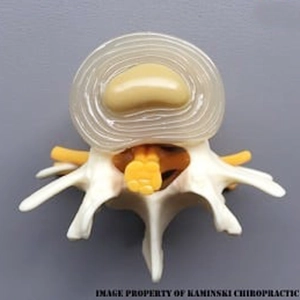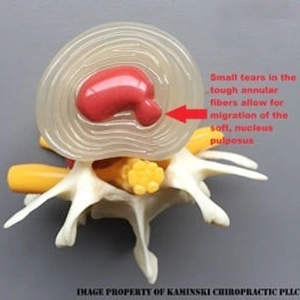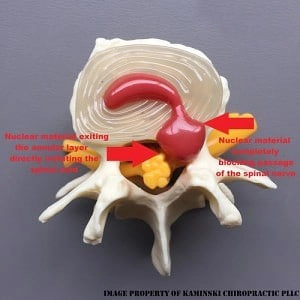Intervertebral Disc Issues in Grand Rapids MI



Description and Overview
Got questions about intervertebral disc issues in Grand Rapids MI? The intervertebral disc is a fibrocartilaginous structure that is present between two vertebrae. It has two different components: the Fibrous annulus and the nucleus palposus. The tough outer layer is composed of fibrous cartilage that gives the disc its strength, allowing the disc to support the weight of the spine above as well as contain the nucleus. The inner portion (nucleus palposus) consists of a jelly-like mucoprotein that allows motion occur at each spinal segment. The intervertebral disc serves 3 basic functions:
- Act as a shock absorber between the vertebrae
- Allow smooth motion throughout the spine
- Provide height between the vertebrae, allowing plenty of space for the spinal nerves to exit from the spine without interference
The highest incidence of disc injury occurs between the ages of 35-45. Males are more commonly affected than women at a ratio of 3:2. The most common levels of disc herniation are L4/L5 and L5/S1 which consists of nearly 95% of all herniations. Although the majority of disc issues occur in the lumbar spine (low back) they can occur anywhere in the spine.
Mechanism of Disc Injury in Grand Rapids MI
There are 5 well-documented likely causes of the majority of disc injuries:
- Chronic overloading of the disc (repetitive bending, lifting, and/or twisting)
- Prior trauma (hard fall, car accident, etc.)
- Asymmetrical loading (bend to the side and lift)
- Poor posture / Muscle imbalances
- Congenital defects (born with it)
When a disc injury occurs, it is usually not the first time the disc has been stressed. Disc issues most commonly accumulate over time. It is not uncommon to have a developing disc issue that is asymptomatic. In a study done by Stadnik et al, they concluded that 81% of asymptomatic people tested had disc bulging present on MRI and 33% had disc protrusion (Radiology, 1998).
4 Stages of Disc Herniation
- Stage 1 - Disc Degeneration: repetitive stress causes discs to weaken and the nucleus shifts over time due to micro tears in the annular fibrous layer. This can also occur due to chemical changes associated with trauma (chronic inflammation has destructive properties to the tissue). May or may not be symptomatic.
- Stage 2 - Prolapse: the disc shifts and the form causes slight impingement to the nerve or spinal cord. Commonly referred to as a bulging disc. More likely to be symptomatic.
- Stage 3 - Extrusion: The nucleus palposus breaks through the fibrous annular layer but remains attached. Typically very symptomatic. Lots of inflammation present increasing chemical irritation to the spinal cord or nerve as well as mechanical irritation.
- Stage 4 - Sequestration: The nucleus palposus breaks through the fibrous annular layer and is separated from the disc into the spinal canal. This is the most serious and takes the longest to heal.
Associated Symptoms and Conditions
- Low back pain
- Neck Pain
- Sciatica
- Pain/Numbness/Tingling/Weakness in legs/feet or arms/hands
- Increased pain with sneezing, coughing, or straining at the stool
- Increased pain while weight bearing
- Increased pain with positional changes
- Degenerative Disc Disease
- Buttock/Glut pain
- Digestive Issues (constipation, diarrhea)
- Bladder Issues (inability to start or hold urine) - Seek
Emergency care if unable to urinate for 12 hours or sudden loss of bowel/bladder control
Whether you're having symptoms or not, chiropractic care helps to realign the vertebrae taking uneven pressure off of the disc. Preventative care decreases the accumulation of wear and tear to stop the degeneration process. An article in the Journal of the American Medical Association suggests patients first seek chiropractic care for the conservative treatment of disc injuries and conditions and surgery should only be considered if all conservative therapies fail.
Contact Kaminski Chiropractic in Grand Rapids MI today to learn more.
OFFICE HOURS
Monday
8:00am - 12:30pm
2:00pm - 6:00pm
Tuesday
8:00am - 12:30pm
2:00pm - 6:00pm
Wednesday
8:00am - 12:30pm
2:00pm - 6:00pm
Thursday
8:00am - 12:30pm
2:00pm - 6:00pm
Friday
Closed
Saturday & Sunday
Closed
Kaminski Chiropractic PLLC
4930 Cascade Rd SE Suite A
Grand Rapids, MI 49546




